In the current scenario, healthcare leaders are extra equipped to increase spending on cybersecurity. But with new threats uncovered every day, it is exhausting to recognize where an organization would be better off investing its budget.

Many healthcare corporations have a range of specialized hospital data systems such as EHR systems, e-prescribing systems, practice management support systems, clinical decision support systems, radiology information systems, and computerized physician order entry systems. Additionally, hundreds of units that contain the Internet of Things ought to be covered as well.
Why is cybersecurity required in the healthcare sector?
We know that the healthcare sector administers too many sensitive records to ignore the importance of cybersecurity. As the industry becomes more reliant on digitization, these matters only become more urgent. IT security in hospitals needs to grow for the good of both medical professionals and patients.
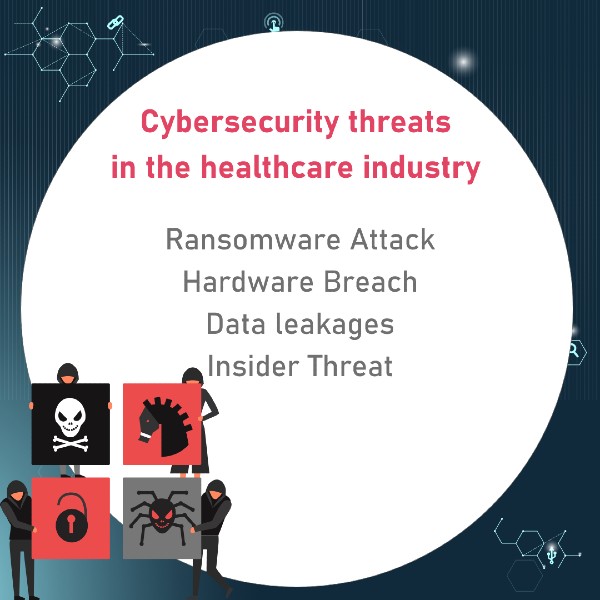
- It helps in reducing the risk of medical errors that can happen daily
- The patient privacy protection will have improvements under IT security
- With the growing technological development, it helps us in taking up a safer technology
- Medical devices will have a safer Operation with the correct precautions
Cybersecurity threats in the healthcare industry
1. Ransomware in Healthcare
Hospital ransomware assaults can be very high-priced as you may additionally face legal penalties, can hurt your reputation, and need to make investments in employee training, hospital cyberattack prevention, and a system for protection.
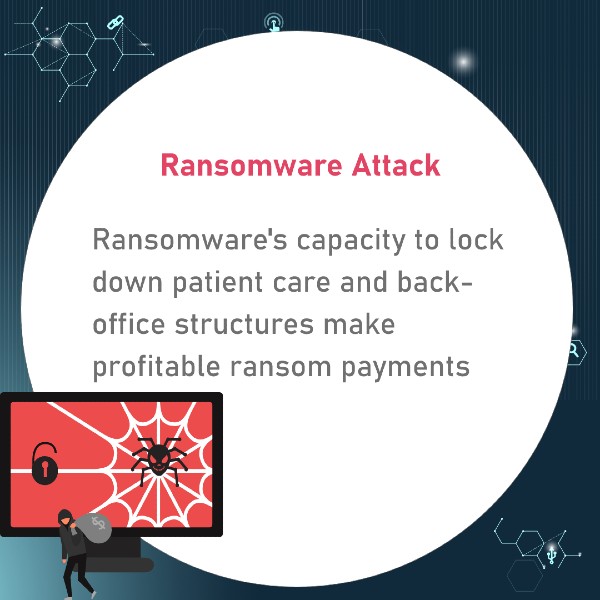
In 2020 the healthcare sector faced ransomware attacks in which about 560 healthcare provider facilities fell victim to the malware variant. The evolving Ransomware as a Service gives people without much technical knowledge, the ability to launch ransomware attacks just by signing up for a service.
2. Data Breaches in Healthcare
Data breaches in healthcare can happen because of fallacious IT security, leaving systems open to malicious hackers, the unauthorized access, sharing, and disclosure of a healthcare setting data, loss or theft of devices, incorrect information disposal, and leaks.
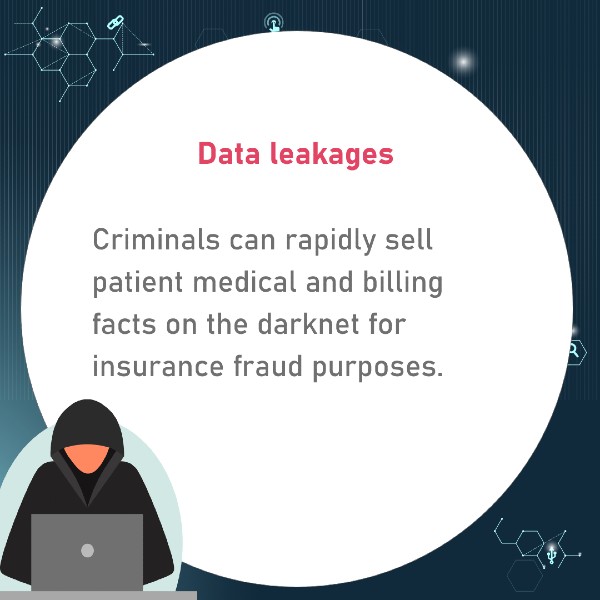
3. Insider Threats in Healthcare
It is one of the most hidden matters that no one puts in their headlines. Employees have legal access to community resources, and they have the proper capability to circumnavigate cybersecurity defences. Healthcare personnel has a deeper grasp of big community algorithms. However, an exceptional-minded worker can rapidly promote the records themselves or sell access codes to hackers. At the same time, other motives are like losing PHI accessed devices.
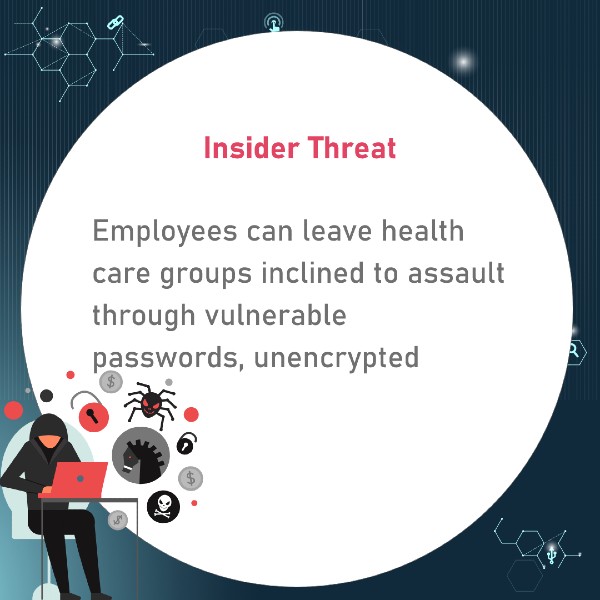
4. DDoS Attacks in Healthcare
DDoS attacks have been developing in size, scope, and frequency for the past various years. Unfortunately, DDoS attacks in healthcare, specifically, have ended up increasingly more common. Patients may additionally be unable to access necessary information, and the reputation of the medical enterprise will become compromised. Individuals might also fear that their information or health archives have become compromised, which might force them to discover any other provider.
5. Hardware Attacks in Healthcare
Internet-connected clinical gadgets are prone to tampering. These devices can be hacked easily by any employee or attacker physically.
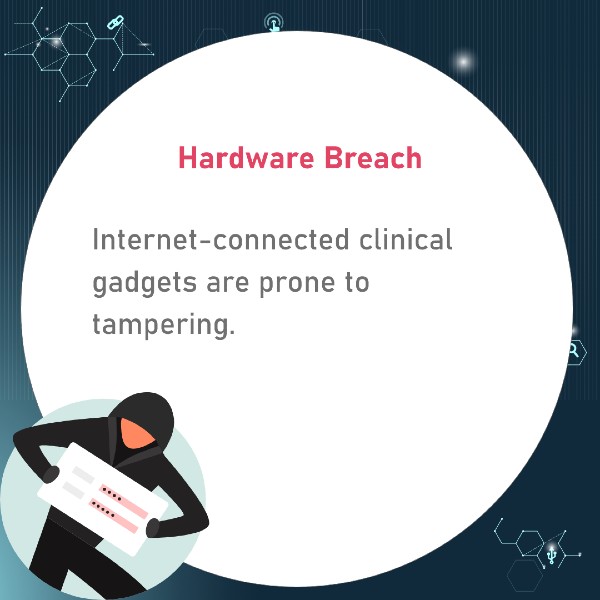
6. Business Email Compromise in Healthcare
Business Email Compromise (BEC) scammers use a spoofed email or compromised account to trick personnel into initiating a cash transfer to a fraudulent bank account. Hospitals and clinical facilities want to be cautious of frauds, which have many versions resulting in lost funds and items such as prescription drugs.
Healthcare organizations attract cybercriminals because of these reasons:
- Ransomware’s capacity to lock down patient care and back-office structures make profitable ransom payments more attractive.
- While encryption is integral for defending health data, it can additionally create blind spots where hackers can conceal from the tools meant to notice breaches.
- Internet-connected clinical gadgets are prone to tampering.
- Criminals can rapidly sell patient medical and billing facts on the darknet for insurance fraud purposes.
- Employees can leave health care groups inclined to assault through vulnerable passwords, unencrypted devices, and other compliance failures.
How can we fix cyberthreats in healthcare?
- Establish a security culture: Every member of an healthcare agency is accountable for defending patient data and thus creating a security culture. Accountability and taking responsibility for data protection need to be amongst the organization’s core values.
- Maintain good computer habits: A new worker onboarding ought to have coaching on exceptional practices for computer use, along with software and operating system maintenance.
- Protect mobile devices: A growing variety of health care carriers are using mobile at work. Encryption and other defensive measures are imperative to make sure that any records on these units are secure.
- Install and maintain anti-virus software: Installing an antivirus software program is no longer enough. Continuous updates are necessary for making sure health care structures acquire high-quality possible protection at any given time.
- Use a firewall: Anything related to the internet has to have a firewall. It can take the form of either a software product or a hardware device. A firewall’s job is to inspect all messages coming into the system from the outside and decide according to predetermined criteria whether the note should be allowed or not and protect from OWASP Top 10 threats.
- Plan for the unexpected: Files need to be backed up often for rapid and convenient data restoration. Organizations have to think about storing these backed-up records away from the central system if possible.
- Control access to protected health information: Access to protected information given to people who want to view or use the data. In many situations like small practices, setting file access permissions is done manually, using an access control list. Someone with authorized rights to the system does it.
- Control physical access: Physical units get stolen when data breaches happen. Computers and other electronics that include secured statistics are stored in locked rooms in impervious areas.
- Use strong passwords and change them regularly: The Verizon record determined that sixty-three percent of validated data breaches concerned taking advantage of passwords that had been the default, weak, or stolen. Health care personnel must no longer use sturdy passwords but ensure they are modified regularly.
- Limit network access: Any software, applications, and other additions to current structures mount with the aid of staff without any prior consent from the suitable organizational authorities.
One organization’s compliance depends appreciably on its capacity to choose and partner with vendors that engage in similarly strong healthcare information protection measures. As the pandemic has so vividly demonstrated, health care provider systems and hospitals have to make computer security a pinnacle priority today. The health and well-being of the patients rely on well-served internet security.





